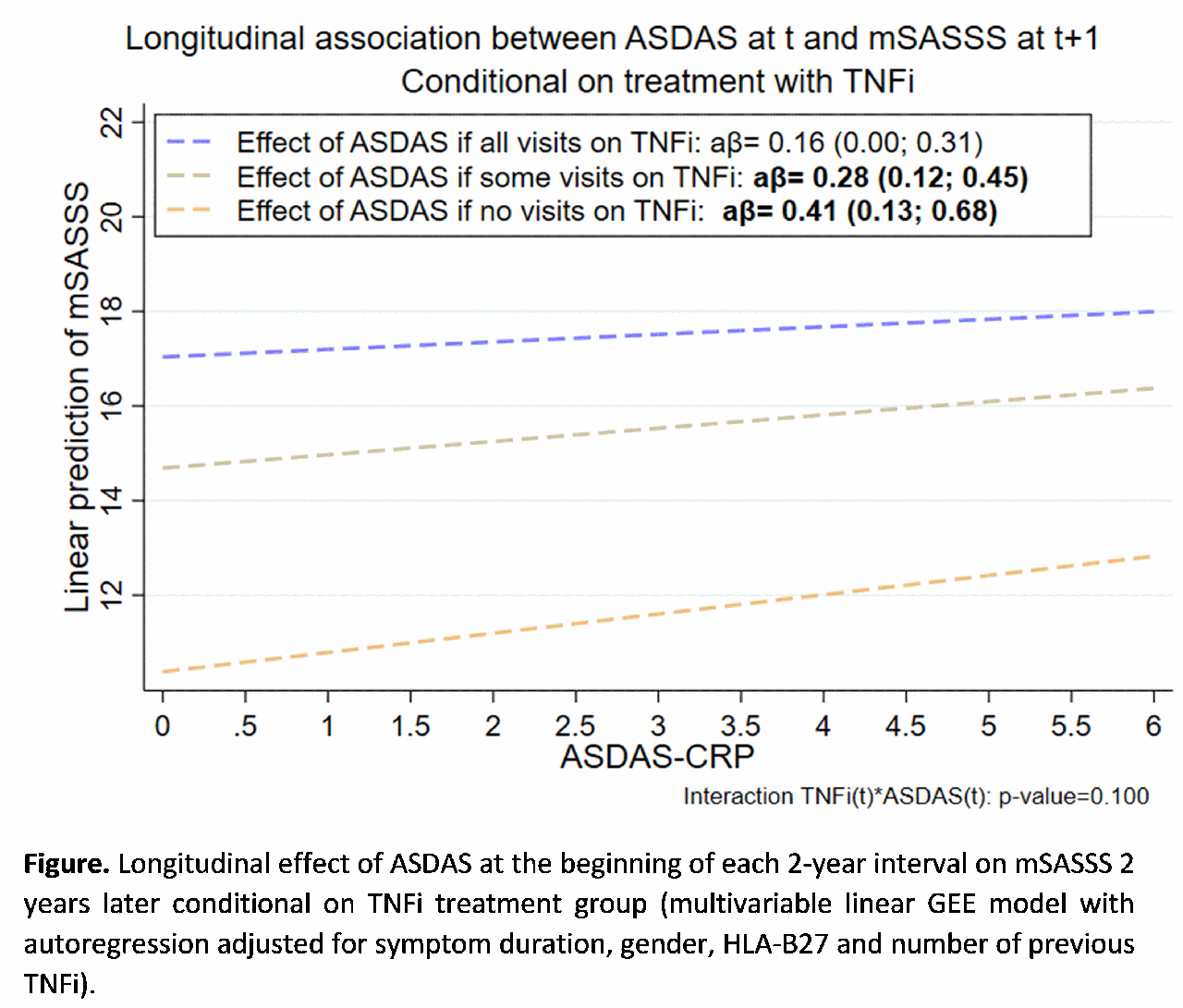Session Information
Session Type: ACR Abstract Session
Session Time: 4:30PM-6:00PM
Background/Purpose: Recent observational data suggest that TNFi reduce spinal radiographic progression in radiographic axial spondyloarthritis (r-axSpA) mostly by inhibiting disease activity1. Yet, resolution on the controversial effect of TNFi on structural progression is yet to be achieved. We aimed to investigate whether in r-axSpA TNFi have an indirect (through ASDAS) and/or direct effect on spinal radiographic progression.
Methods: Patients (pts) with axial spondyloarthritis (axSpA) fulfilling the modified New York criteria (mNY) were included in this prospective, observational cohort (ALBERTA FORCAST). Clinical and imaging data were collected at baseline and every 2 years up to 10 years of follow-up. Radiographs of the spine were independently scored by 2 central readers and one adjudicator (if disagreement), with known chronological order but blinded to clinical data, using the modified Stoke Ankylosing Spondylitis Spine Score (mSASSS). The indirect effect of TNFi on mSASSS progression was evaluated by testing the interaction between TNFi and ASDAS at the start of each 2-year interval (t). If significant (p< 0.15) the association between ASDAS at t and mSASSS at the end of the interval (t+1) was assessed in 3 groups of exposure to TNFi: i. treatment in all visits; ii. treatment in some visits and iii. Never treated. The direct effect of TNFi on mSASSS progression was evaluated by testing the association between TNFi at t and mSASSS at t+1 (adjusting for ASDAS at t). Multivariable GEE models adjusted for mSASSS at t (autoregression) and for a set of potential confounders defined a priori on clinical grounds (Figure). In a sensitivity analysis, the direct effect of TNFi was also tested after adjusting for a propensity score (PS), to take confounding by indication into account.
Results: In total, 314 pts were included [74% males, mean symptom duration 17.8 (SD 11.7) years, 83% HLA-B27 positive and 7% previously treated with ≥1 TNFi]. The interaction between ASDAS and TNFi at t was significant (p=0.10). A gradient was seen for the effect of ASDAS at t on mSASSS at t+1, which was more than 2 times higher in patients never treated with TNFi (β (95% CI): 0.41 (0.13; 0.68) compared to those always treated [β (95% CI): 0.16 (0.00; 0.31)] (Figure), showing that treatment with TNFi diminishes the effect of ASDAS on mSASSS. In addition to the indirect effect, TNFi also directly associated with less mSASSS progression: Pts receiving TNFi at t had on average 0.87 mSASSS-units less on t+1 compared to those not treated [β (95% CI): -0.85 (-1.35; -0.35)] and this was noted independently of ASDAS. Importantly, this effect remained significant after PS-adjustment [β (95% CI): -0.80 (-1.37; -0.22)].
Conclusion: This data indicates that treatment with TNFi limits spinal radiographic progression in pts with r-axSpA only partially by decreasing disease activity. A direct effect of TNFi in reducing mSASSS progression, and independent of ASDAS inflammation, is also seen suggesting that other mechanisms also contribute to structural modification by TNFi.
To cite this abstract in AMA style:
Sepriano A, Ramiro S, Wichuk S, Chiowchanwisawakit P, MacCosham T, Paschke J, van der Heijde D, Landewé R, Maksymowych W. TNF Inhibitors Reduce Spinal Radiographic Progression in Axial Spondyloarthritis by Mechanisms Associated with but Also Independent of Disease Activity [abstract]. Arthritis Rheumatol. 2019; 71 (suppl 10). https://acrabstracts.org/abstract/tnf-inhibitors-reduce-spinal-radiographic-progression-in-axial-spondyloarthritis-by-mechanisms-associated-with-but-also-independent-of-disease-activity/. Accessed .« Back to 2019 ACR/ARP Annual Meeting
ACR Meeting Abstracts - https://acrabstracts.org/abstract/tnf-inhibitors-reduce-spinal-radiographic-progression-in-axial-spondyloarthritis-by-mechanisms-associated-with-but-also-independent-of-disease-activity/

